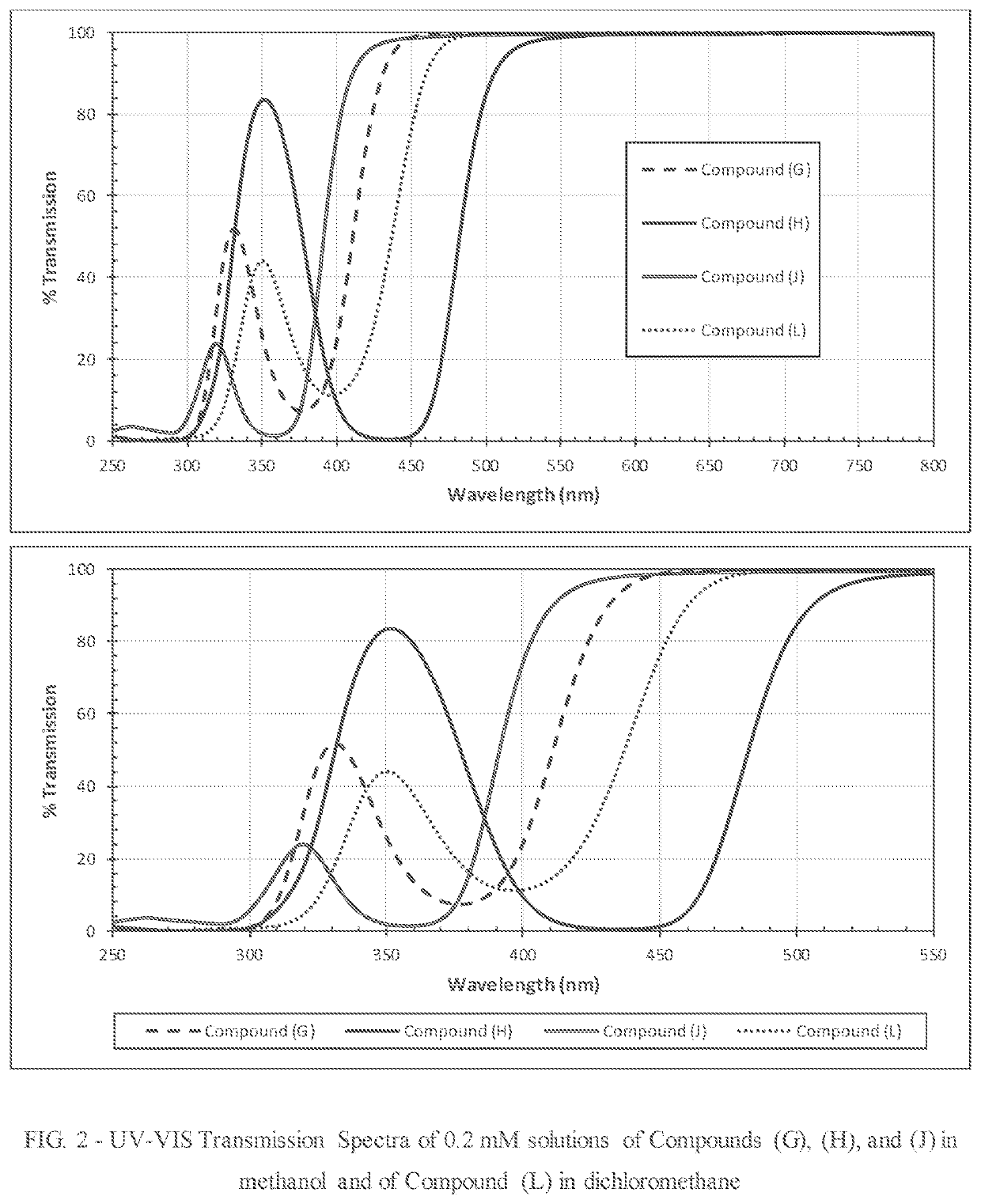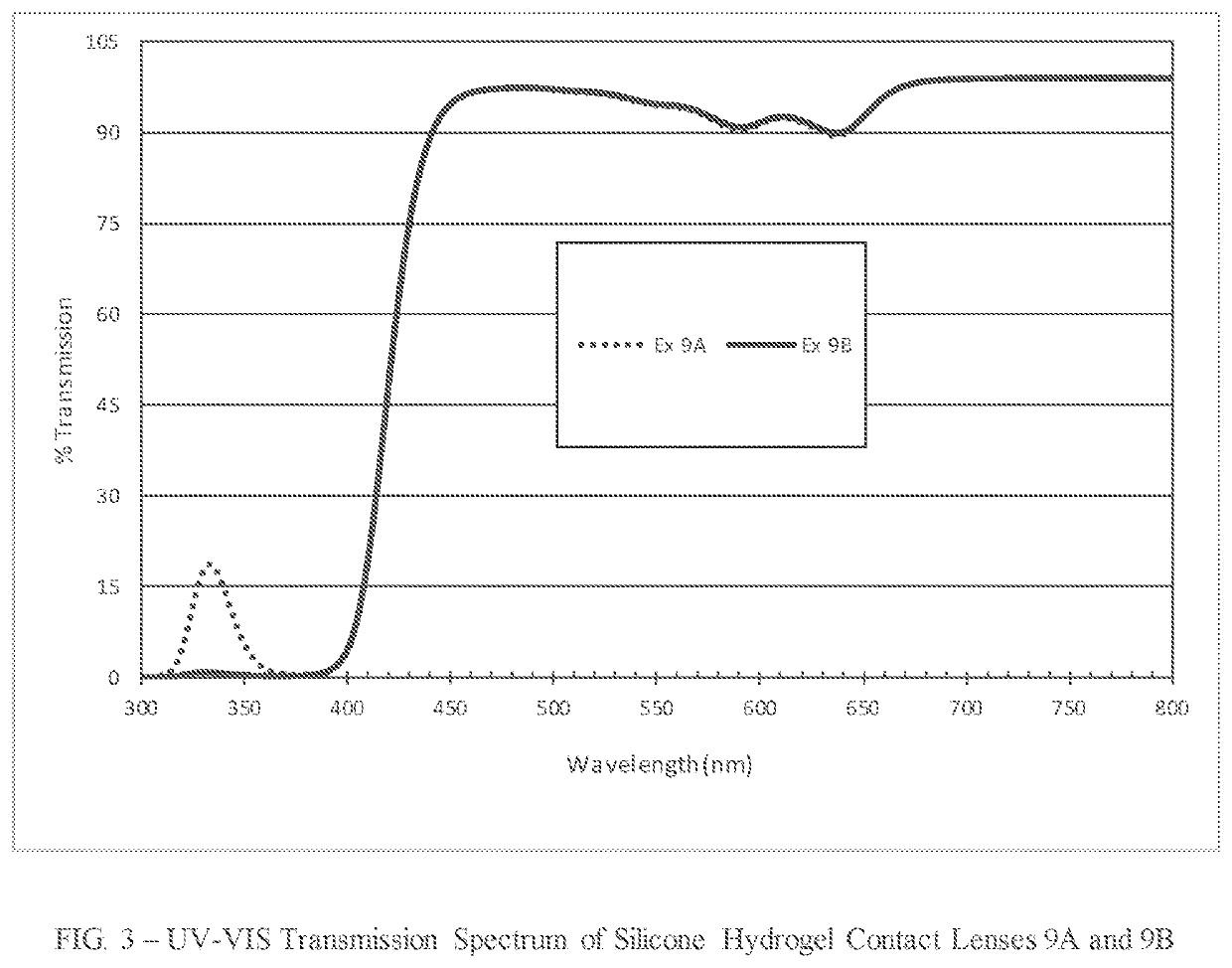Polymerizable absorbers of UV and high energy visible light
- Summary
- Abstract
- Description
- Claims
- Application Information
AI Technical Summary
Benefits of technology
Problems solved by technology
Method used
Image
Examples
example 1
of 2-(2-cyanoacetamido)ethyl methacrylate (A) and 2-(2-cyano-2-(9H-thioxanthen-9-ylidene)acetamido)ethyl methacrylate (B) as Shown in Scheme 2
[0341]
[0342]Methyl cyanoacetate (40 grams, 0.4037 mole) and 25 mL of dichloromethane were stirred in a 3 neck, 500 mL round bottom flask under equipped with a reflux condenser under a nitrogen environment. 2-aminoethanol (23.8 grams, 0.3897 mole, ˜0.97 eq.) was added to the solution via an addition funnel, after which the temperature rose and the methylene chloride began to reflux. After the exotherm ceased, external heat was applied to continue a gentle reflux for a total of two hours, after which no ethanolamine was observed by thin layer chromatography.
[0343]The reaction may also be conducted at room temperature and is complete within a few hours.
[0344]The mixture was cooled to room temperature and all the methylene chloride was evaporated at reduced pressure. The residual oil was washed three times with 50 mL of ethyl acetate to remove unr...
example 2
of 2-(2-cyano-2-(9H-xanthen-9-ylidene)acetamido)ethyl methacrylate (C) as Shown in Scheme 3
[0347]
[0348]A mixture of 9H-xanthen-9-one (5.0 grams, 0.0255 mole) and thionyl chloride (10 mL, 16.4 grams, 0.138 mole) was refluxed in a 50 mL round bottom flask under a nitrogen atmosphere with constant stirring. After three hours, the red solution was evaporated to dryness ensuring that all unreacted thionyl chloride was removed from the system. 2-(2-cyanoacetamido)ethyl methacrylate (A) (6.0 grams, 0.0306 mole, ˜1.2 eq.) and 20 mL of dichloromethane were added and the resulting reaction mixture was heated to reflux under a nitrogen blanket. The reaction was monitored by thin layer chromatography. The mixture was cooled to room temperature after 2.5 hours and 2-(2-cyano-2-(9H-xanthen-9-ylidene)acetamido)ethyl methacrylate (C) purified after passing through a short silica gel column (CH2Cl2, and ethyl acetate in CH2Cl2). The off-white precipitate formed during rotary evaporation is washed wi...
example 3
of 2-(2-cyano-2-(10-methylacridin-9(10H)-ylidene)acetamido)ethyl methacrylate (D) as Shown in Scheme 4 (Prophetic)
[0349]
[0350]A mixture of 10-methylacridin-9(10H)-one (2.09 grams, 0.01 mole) and thionyl chloride (5 mL, 8.2 grams, ˜0.07 mole) is refluxed in a 50 mL round bottom flask under a nitrogen atmosphere with constant stirring. After two hours, the solution is evaporated to dryness ensuring that all unreacted thionyl chloride is removed from the system. 2-(2-cyanoacetamido)ethyl methacrylate (A) (2.3 grams, 0.0117 mole, ˜1.17 eq.) and 15 mL of dichloromethane are added and the resulting reaction mixture is heated to reflux under a nitrogen blanket. The reaction is monitored by thin layer chromatography. When no changes are observed in the chromatogram, the reactive mixture is allowed to cool down to room temperature. 2-(2-cyano-2-(10-methylacridin-9(10H)-ylidene)acetamido)ethyl methacrylate (D) may be isolated by known methods, for instance after passing through a short silica...
PUM
 Login to View More
Login to View More Abstract
Description
Claims
Application Information
 Login to View More
Login to View More - R&D
- Intellectual Property
- Life Sciences
- Materials
- Tech Scout
- Unparalleled Data Quality
- Higher Quality Content
- 60% Fewer Hallucinations
Browse by: Latest US Patents, China's latest patents, Technical Efficacy Thesaurus, Application Domain, Technology Topic, Popular Technical Reports.
© 2025 PatSnap. All rights reserved.Legal|Privacy policy|Modern Slavery Act Transparency Statement|Sitemap|About US| Contact US: help@patsnap.com



